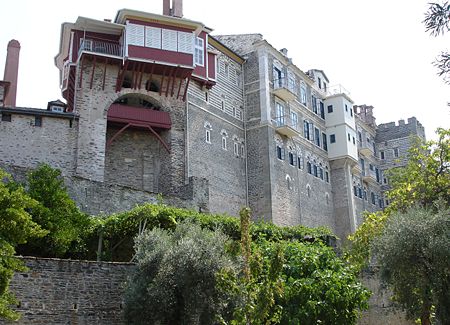Monastère de Vatopedi (Mont Athos) : Différence entre versions
| Ligne 1 : | Ligne 1 : | ||
| − | Le '''Monastère de Vatopedi''' est un des vingt monastères du [[République monastique du Mont Athos|Mont Athos]]. | + | [[Image:Vatopedi Monastery.JPG|450px|right|thumb|Monastère de Vatopedi]]Le '''Monastère de Vatopedi''' est un des vingt monastères du [[République monastique du Mont Athos|Mont Athos]]. |
Il est situé au nord-est de la péninsule. | Il est situé au nord-est de la péninsule. | ||
| Ligne 8 : | Ligne 8 : | ||
== Histoire == | == Histoire == | ||
| + | Some sources associate the name of "Vatopedi" with the flora of the surrounding countryside (vatos = shrub, pedion = plain or ground); others point to a traditional story in which Emperor Arcadius built the monastery to honor the saving of his son from shipwreck by the Theotokos; the child was found in a bush (vato = brier, paidi = child). | ||
| + | |||
| + | The monastery was founded in 972 AD by three monks: Athanasius, Nicholas, and Antonius, who were students of St. Anthanasius of Lavra. The major parts of the monastery were constructed either during the Byzantine period or later, during the eighteenth and nineteenth centuries, when building reached its peak. The monastery is monumental in size, with a tall wall in which the buildings are placed in triangular form. | ||
== Liens internes == | == Liens internes == | ||
Version actuelle datée du 2 janvier 2009 à 12:45
Il est situé au nord-est de la péninsule.
Il occupe la 2ème place dans le classement hiérarchique.
En 1999, il comptait 80 moines (beaucoup originaires de Chypre).
Histoire
Some sources associate the name of "Vatopedi" with the flora of the surrounding countryside (vatos = shrub, pedion = plain or ground); others point to a traditional story in which Emperor Arcadius built the monastery to honor the saving of his son from shipwreck by the Theotokos; the child was found in a bush (vato = brier, paidi = child).
The monastery was founded in 972 AD by three monks: Athanasius, Nicholas, and Antonius, who were students of St. Anthanasius of Lavra. The major parts of the monastery were constructed either during the Byzantine period or later, during the eighteenth and nineteenth centuries, when building reached its peak. The monastery is monumental in size, with a tall wall in which the buildings are placed in triangular form.
